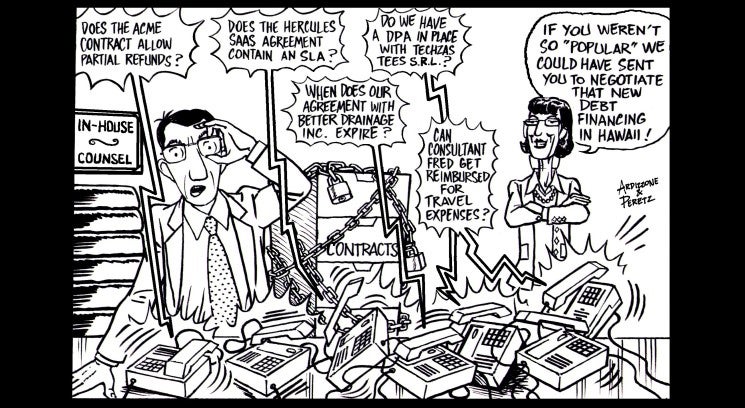
As an in-house lawyer, your workload is unlikely to decrease as new regulations arise, customer agreements are signed, and your business grows. Even if your business is shrinking, you will be engaged in renegotiating deals with suppliers and restructuring your employment and contractor relationships.
So how do you keep up? Traditional aphorisms abound, yet offer little real guidance:
- “Work smarter, not harder!”
- “It’s not the load that breaks you down; it’s the way you carry it.”
- “The Problem is not the problem. The problem is your attitude about the Problem.”
- "Focus on being productive instead of busy."
Fear not! There are practical steps you can take that can make a huge impact on your productivity and your client’s satisfaction.
Build a process
Much of the work that in-house lawyers encounter may involve repetitive tasks that do not require the expertise of a senior lawyer, or even a lawyer at all. For example, nondisclosure agreements often contain a provision allowing the disclosing party to protect its trade secrets by demanding that confidential information be returned or destroyed before the nondisclosure agreement expires. The essential step of sending a letter demanding return of the confidential information can be handled by a non-lawyer.
Is it worthwhile to train a non-lawyer on this task? Absolutely. Most companies that have one nondisclosure agreement in place likely have many more. Thus, training the non-lawyer to handle this important, but repetitive, task can result in frequent time savings for the lawyer who has delegated the work.
Whenever you encounter a problem, consider whether you have seen a similar problem in the past. If so, spend a bit more time on your solution by developing materials to enable others to handle all or part of the task for you. You may need to create templates, guidelines, or team training to enable others to help you out. Make that upfront investment in your colleagues and it will pay ongoing time dividends to you for repetitive tasks.
You need to have the mindset that your time is the most valuable legal resource available to the company and you. Use it for the most important decisions and analysis, not the repeating tasks that could be handled by someone with fewer or no legal skills.
Fortunately, there is a new wave in software to help you automate many of the nonlegal tasks that you encounter — it’s called Robotic Process Automation (RPA). Companies like UIPath, Nintex, and ServiceNow offer RPA tools that enable you to break down work processes into steps that can be handled for you by software.
For example, if you spot that a key supplier agreement will auto-renew, you can trigger a robotic process to notify procurement to seek competitive bids and ask the relevant users of the supplier’s products about whether they are satisfied. Your legal analysis of the business agreement serves as the key trigger for a series of subsequent steps that can be shepherded throughout your organization by RPA-driven workflows.
WTSD
If you are answering the same question repeatedly or doing similar tasks over and over, it’s time to employ WTSD: Write the Stuff Down. People may be asking these questions because you are the only source for the answer. Once you write down the answer or process, you can readily share it with others with the click of a button or re-direction to internal software or an intranet page.
I have spoken to several in-house attorneys about their use of Contract Wrangler, which is an enterprise-wide system that shares key terms, dates, and deliverables in business agreements across the enterprise. One of the most surprising revelations for these attorneys is how much free time appears in their schedule when they give their business clients direct access to information from corporate contracts.
Suddenly, the in-house attorneys are recapturing several hours of time per week because their information technology team can directly look up the service level promises of vendors and their business development leader can directly ascertain which exclusivities will end soon.
Your organization likely already has group communication tools in place, ranging from Slack to Google Docs to an Intranet or Wiki, that you can utilize to share what you have written down. These are perfect places to post your answers to frequently asked questions, along with worksheets and decision trees that help your internal clients understand how you would likely answer the question.
Until you start writing down answers and processes, information flow in your organization is like a hub-and-spoke system, where you are the only hub through which all queries must pass. Once you start transferring your knowledge and thought process into enterprise systems accessible by your clients, you no longer need to be the endpoint for every question and query, regardless of how mundane.
But won’t committing my perspectives and processes to writing dilute my importance to the organization? Not at all. Steve Kerr, the coach of the Golden State Warriors basketball team, is no less important because he shares his insights about coaching and team building.
Rather, sharing those insights increases his influence and value to his players and assistant coaches and reinforces his role as a leader. Your next intranet posting on how the executives should handle sales contract negotiations could do the same for your influence and value.
Scope and plan first — act later
You have a new assignment to support a key business initiative. Don’t just jump into the work. Instead, treat most requests like a project, where you think through and document the long-term objective.
Spend time trying to find out what your clients really need by asking them what they plan to use it for. Otherwise, you may discover later that they were not sufficiently articulate in their request, which means that your work product tailored to their request is not what they really want.
Chart out the steps required to achieve the end goal and tally the resources and inputs you require. All of these details, particularly a reliance on others, impact the timing of your work. Once you identify external dependencies in your process, you can explore whether these can be started sooner or expedited, perhaps with the support of your client.
Over time you will develop your own standard project kickoff checklist, which will include questions like:
- What will my client do with this result?
- What other information sources do I require? Who am I dependent on to procure these?
- Are there key assumptions about the future that could dramatically change the result?
- What are the logical points to check-in with my client about progress?
Planning ahead provides you the best opportunity to clarify goals and secure resources and information that will have a huge impact on the quality and timing of your work.
It’s not a hack
It’s fun to read lists of 10 surefire secret methods to dramatically expanding your output or to dream about completing our entire workweek in four hours. However, we are not proposing a “get time-rich” scheme here.
Instead, we have outlined a process that you can tailor to your work environment to give you leverage. Following the steps described above can dramatically enhance the impact of your work and free you to engage in tasks that are more intellectually challenging or career-enhancing.





